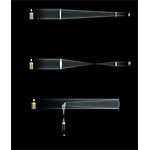Lenses and mirrors (either concave or convex) have singular optical properties. All the main types of telescope developed starting from Galileo are based on various combinations of lenses and mirrors. Each combination has its own advantages and disadvantages. The “Galilean” telescope (convex objective lens and concave ocular lens) produces upright images, but has a very narrow field of view. The telescope designed by Kepler (1571-1630), with both the objective and the ocular lenses convex, has a wider field of view but produces upside-down images. The one perfected by Newton (1642-1727) uses a concave mirror as objective. Its field of view is wide, but the images it produces are upside-down.
The Galilean telescope produces upright images. The rays of light are deviated by the semi-convex objective lens and become parallel again – without intersecting – while traversing the semi-concave ocular lens.
The Keplerian telescope produces upside-down images. The rays of light, deviated by the bi-convex objective lens, intersect and become parallel again while traversing the ocular lens, which is bi-convex as well.
The Newtonian telescope produces upside-down images. The rays of light are reflected by the concave objective mirror, then reflected again by the plane secondary mirror, intersect and become parallel again while traversing the bi-convex ocular lens.











